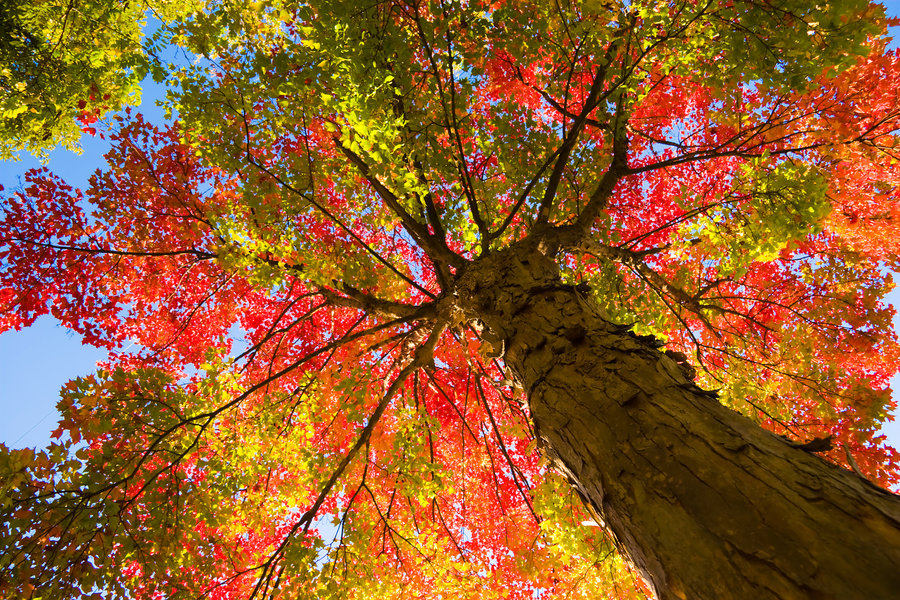Posted on November 15, 2016 in Gardening

Page Contents
Here are our tips to manage trees, leaves and climbers.
Autumn and winter bring challenges with trees, leaves and climbers. Some management now can save time and effort later, when you may have to repair unnecessary damage.
Leaves – clear them
Clear leaves as soon as you can; waiting until the end of autumn is too late. If you leave them on your lawn for long periods, they’ll reduce the amount of light that reaches the grass and make it turn yellow.
A lawn rake is fine for large, flat areas of lawn but impractical for borders, so consider investing in a garden vacuum. If you use it on shredder mode, the leaves will rot down much more quickly when composted. Add them to your compost bin in thin layers along with other organic matter.
Pro tip: Avoid yellowing grass by clearing leaves frequently, a little at a time.
Support your trees
Autumn brings strong winds, so newly-planted trees will need to be staked. This prevents rocking damage, which can uplift and destroy their root anchorage, or cause them to snap. Instead of using a single, vertical stake, use an angled one which will allow the tree to move in the breeze instead of staying totally rigid – swaying is proven to promote trunk growth.
Pro tip: Manage trees in very windy, or exposed areas, use a double stake. Two stakes are hammered into the ground, side by side, and one or two horizontal braces are then screwed to them. Then tie the tree to the braces.
Strengthen your climbers:
Climbers, clematis and climbing roses will all need some kind of frame to grow up when they start to put on new growth in the spring. Frames comes in different shapes, which define the direction that your plants grow in:
- Trellises can be attached to fencing or the sides of structures so that your climbers can spread outwards and upwards.
- A series of climbing wires can be a more flexible option than trellis – it can be added to, and expanded, as your plant grows.
- Obelisks are freestanding, tapered pillars that encourage your plants to grow upwards.
- Arches allow your plants to grow up and over a pathway, or entrance to another area of your garden.
Pro tip: Putting these structures in place now, as they’ve reached the end of their growing season, will save a struggle come spring.
Categories
- Building Maintenance
- Cleaning
- Electrical
- Gardening
- General Info
- Our Service
- Pest
- Security
- Uncategorized
- Waste Solutions
Archive
- April 2024
- March 2024
- February 2024
- January 2024
- December 2023
- November 2023
- August 2023
- April 2023
- February 2023
- January 2023
- December 2022
- November 2022
- October 2022
- September 2022
- August 2022
- July 2022
- June 2022
- May 2022
- April 2022
- March 2022
- February 2022
- January 2022
- December 2021
- October 2021
- September 2021
- August 2021
- July 2021
- June 2021
- May 2021
- April 2021
- March 2021
- February 2021
- January 2021
- December 2020
- November 2020
- October 2020
- September 2020
- August 2020
- July 2020
- June 2020
- May 2020
- April 2020
- March 2020
- February 2020
- January 2020
- December 2019
- November 2019
- October 2019
- September 2019
- August 2019
- July 2019
- June 2019
- May 2019
- April 2019
- March 2019
- February 2019
- January 2019
- December 2018
- November 2018
- October 2018
- September 2018
- August 2018
- July 2018
- June 2018
- May 2018
- April 2018
- March 2018
- February 2018
- January 2018
- December 2017
- November 2017
- October 2017
- September 2017
- August 2017
- July 2017
- June 2017
- May 2017
- April 2017
- March 2017
- February 2017
- January 2017
- December 2016
- November 2016
- October 2016
- September 2016
- August 2016
- July 2016
- June 2016
- May 2016
- April 2016
- March 2016
- February 2016
- January 2016
- December 2015
- November 2015
- October 2015
- September 2015
- August 2015
- July 2015
- June 2015
- May 2015
- April 2015
- March 2015
- February 2015
- January 2015
- October 2014
- May 2013
- April 2013
- November 2011
- September 2011
- June 2011
- January 2011
- December 2010
- November 2010

